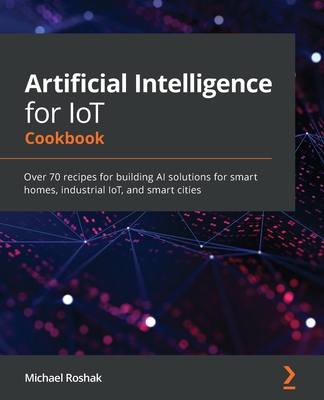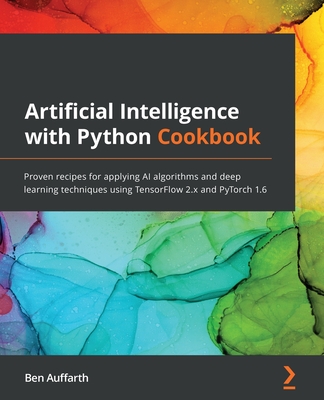Artificial Intelligence for IoT Cookbook: Over 70 recipes for building AI solutions for smart homes, industrial IoT, and smart cities
暫譯: 物聯網人工智慧食譜:超過70個建構智慧家庭、工業物聯網及智慧城市AI解決方案的食譜
Roshak, Michael
- 出版商: Packt Publishing
- 出版日期: 2021-03-05
- 售價: $1,660
- 貴賓價: 9.5 折 $1,577
- 語言: 英文
- 頁數: 260
- 裝訂: Quality Paper - also called trade paper
- ISBN: 1838981985
- ISBN-13: 9781838981983
-
相關分類:
Machine Learning、物聯網 IoT
-
相關翻譯:
人工智能與物聯網 (簡中版)
海外代購書籍(需單獨結帳)
商品描述
Implement machine learning and deep learning techniques to perform predictive analytics on real-time IoT data
Key Features
- Discover quick solutions to common problems that you'll face while building smart IoT applications
- Implement advanced techniques such as computer vision, NLP, and embedded machine learning
- Build, maintain, and deploy machine learning systems to extract key insights from IoT data
Book Description
Artificial intelligence (AI) is rapidly finding practical applications across a wide variety of industry verticals, and the Internet of Things (IoT) is one of them. Developers are looking for ways to make IoT devices smarter and to make users' lives easier. With this AI cookbook, you'll be able to implement smart analytics using IoT data to gain insights, predict outcomes, and make informed decisions, along with covering advanced AI techniques that facilitate analytics and learning in various IoT applications.
Using a recipe-based approach, the book will take you through essential processes such as data collection, data analysis, modeling, statistics and monitoring, and deployment. You'll use real-life datasets from smart homes, industrial IoT, and smart devices to train and evaluate simple to complex models and make predictions using trained models. Later chapters will take you through the key challenges faced while implementing machine learning, deep learning, and other AI techniques, such as natural language processing (NLP), computer vision, and embedded machine learning for building smart IoT systems. In addition to this, you'll learn how to deploy models and improve their performance with ease.
By the end of this book, you'll be able to package and deploy end-to-end AI apps and apply best practice solutions to common IoT problems.
What you will learn
- Explore various AI techniques to build smart IoT solutions from scratch
- Use machine learning and deep learning techniques to build smart voice recognition and facial detection systems
- Gain insights into IoT data using algorithms and implement them in projects
- Perform anomaly detection for time series data and other types of IoT data
- Implement embedded systems learning techniques for machine learning on small devices
- Apply pre-trained machine learning models to an edge device
- Deploy machine learning models to web apps and mobile using TensorFlow.js and Java
Who this book is for
If you're an IoT practitioner looking to incorporate AI techniques to build smart IoT solutions without having to trawl through a lot of AI theory, this AI IoT book is for you. Data scientists and AI developers who want to build IoT-focused AI solutions will also find this book useful. Knowledge of the Python programming language and basic IoT concepts is required to grasp the concepts covered in this artificial intelligence book more effectively.
商品描述(中文翻譯)
**實作機器學習和深度學習技術,以對即時物聯網(IoT)數據進行預測分析**
#### 主要特點
- 發現構建智慧物聯網應用程式時常見問題的快速解決方案
- 實作先進技術,如計算機視覺、自然語言處理(NLP)和嵌入式機器學習
- 建立、維護和部署機器學習系統,以從物聯網數據中提取關鍵見解
#### 書籍描述
人工智慧(AI)正在各行各業迅速找到實際應用,而物聯網(IoT)就是其中之一。開發人員正在尋找方法使物聯網設備更智能,並使用戶的生活更輕鬆。通過這本AI食譜書,您將能夠使用物聯網數據實作智慧分析,以獲取見解、預測結果並做出明智的決策,同時涵蓋促進各種物聯網應用分析和學習的先進AI技術。
本書採用食譜式的方法,將帶您了解數據收集、數據分析、建模、統計和監控以及部署等基本過程。您將使用來自智慧家庭、工業物聯網和智慧設備的實際數據集來訓練和評估從簡單到複雜的模型,並使用訓練好的模型進行預測。後面的章節將帶您了解在實作機器學習、深度學習和其他AI技術(如自然語言處理、計算機視覺和嵌入式機器學習)以構建智慧物聯網系統時所面臨的主要挑戰。此外,您還將學習如何輕鬆部署模型並改善其性能。
在本書結束時,您將能夠打包和部署端到端的AI應用程式,並將最佳實踐解決方案應用於常見的物聯網問題。
#### 您將學到什麼
- 探索各種AI技術,從零開始構建智慧物聯網解決方案
- 使用機器學習和深度學習技術構建智慧語音識別和面部檢測系統
- 使用算法獲取物聯網數據的見解並將其應用於項目
- 對時間序列數據和其他類型的物聯網數據進行異常檢測
- 實作嵌入式系統學習技術,以在小型設備上進行機器學習
- 將預訓練的機器學習模型應用於邊緣設備
- 使用TensorFlow.js和Java將機器學習模型部署到網頁應用程式和移動設備
#### 本書適合誰
如果您是物聯網從業者,想要整合AI技術來構建智慧物聯網解決方案,而不必深入研究大量AI理論,那麼這本AI物聯網書籍適合您。希望構建以物聯網為重點的AI解決方案的數據科學家和AI開發人員也會發現這本書有用。為了更有效地理解本書中涵蓋的概念,您需要具備Python程式語言的知識和基本的物聯網概念。
作者簡介
Michael Roshak is a cloud architect and strategist with extensive subject matter expertise in enterprise cloud transformation programs and infrastructure modernization through designing, and deploying cloud-oriented solutions and architectures. He is responsible for providing strategic advisory for cloud adoption, consultative technical sales, and driving broad cloud services consumption with highly strategic accounts across multiple industries. --This text refers to the paperback edition.
作者簡介(中文翻譯)
Michael Roshak 是一位雲端架構師和策略專家,擁有豐富的企業雲端轉型計畫和基礎設施現代化的專業知識,專注於設計和部署雲端導向的解決方案和架構。他負責提供雲端採用的策略諮詢、技術銷售諮詢,並推動多個行業中高度策略性客戶的廣泛雲端服務消費。 --此文本指的是 平裝本 版本。
目錄大綱
Table of Contents
- Setting up the IoT and AI Environment
- Handling Data
- Machine Learning for IoT
- Deep Learning for Predictive Maintenance
- Anomaly Detection
- Computer Vision
- NLP and Bots for Self-Ordering Kiosk
- Optimizing with Microcontrollers and Pipelines
- Deploying to the Edge
目錄大綱(中文翻譯)
Table of Contents
- Setting up the IoT and AI Environment
- Handling Data
- Machine Learning for IoT
- Deep Learning for Predictive Maintenance
- Anomaly Detection
- Computer Vision
- NLP and Bots for Self-Ordering Kiosk
- Optimizing with Microcontrollers and Pipelines
- Deploying to the Edge










